Family: Tenthredinidae
Family common name: common sawflies
Subfamily: Selandriinae
Tribe: Dolerini
Genus: Dolerus Panzer, 1801
Subgenera: Dolerus, Achaetoprion, Cyperolerus, Dicrodolerus, Equidolerus, Loderus, Neodolerus, Oncodolerus, Poodolerus
The Tenthredinidae are the most species-rich family and are found throughout the world, in all continents but Antarctica. They are known as the “common sawflies.” They can generally be recognized by a cylindrical body and long, segmented antennaeantenna:
the sensory organ emerging from the front of the head, usually between the compound eyes and above the clypeus; includes the flagellum, scape and pedicel
 . Otherwise, they come in a variety of colors, sizes, and forms (Goulet 1992Goulet 1992:
. Otherwise, they come in a variety of colors, sizes, and forms (Goulet 1992Goulet 1992:
Goulet H. 1992. The genera and subgenera of the sawflies of Canada and Alaska: Hymenoptera. Symphyta. The insects and arachnids of Canada. Part 20. Agriculture Canada Publication.).
Sawflies in the Selandriinae subfamily are relatively small and slender. The range of Selandriinae is worldwide; it occurs on all continents except Antarctica (Goulet 1992Goulet 1992:
Goulet H. 1992. The genera and subgenera of the sawflies of Canada and Alaska: Hymenoptera. Symphyta. The insects and arachnids of Canada. Part 20. Agriculture Canada Publication.). It is the most common and diverse group of tenthredinids in tropical regions, particularly in Central America, South America, and Southeast Asia (Smith 1969eSmith 1969e:
Smith DR. 1969e. Nearctic Sawflies. II. Selandriinae: Adults (Hymenoptera: Tenthredinidae). Technical Bulletin, U.S. Department of Agriculture 1398: 1-48.). Selandriinae contains the only known sawflies that feed on non-vascular plants, specifically ferns (Smith et al. 2013Smith et al. 2013:
Smith DR, Janzen DH and Hallwachs W. 2013. Food plants and life histories of sawflies of the families Argidae and Tenthredinidae (Hymenoptera) in Costa Rica, a supplement. Journal of Hymenoptera Research 35: 17-31. https://doi.org/10.3897/JHR.35.5496). The subfamily can be distinguished from other subfamilies by wing venationvenation:
the network of veins on a wing
(Goulet 1992Goulet 1992:
Goulet H. 1992. The genera and subgenera of the sawflies of Canada and Alaska: Hymenoptera. Symphyta. The insects and arachnids of Canada. Part 20. Agriculture Canada Publication.).
Dolerus is a species-rich genus recorded throughout the world (Taeger et al. 2010Taeger et al. 2010:
Taeger A, Blank SM, and Liston AD. 2010. World Catalog of Symphyta (Hymenoptera). Zootaxa 2580: 1-1064.). There are many forms, but the genus is best recognized by distinctive pits on the head and mesoscutummesoscutum:
the central and dorsal portion of the thorax between the scutellum and postnotum
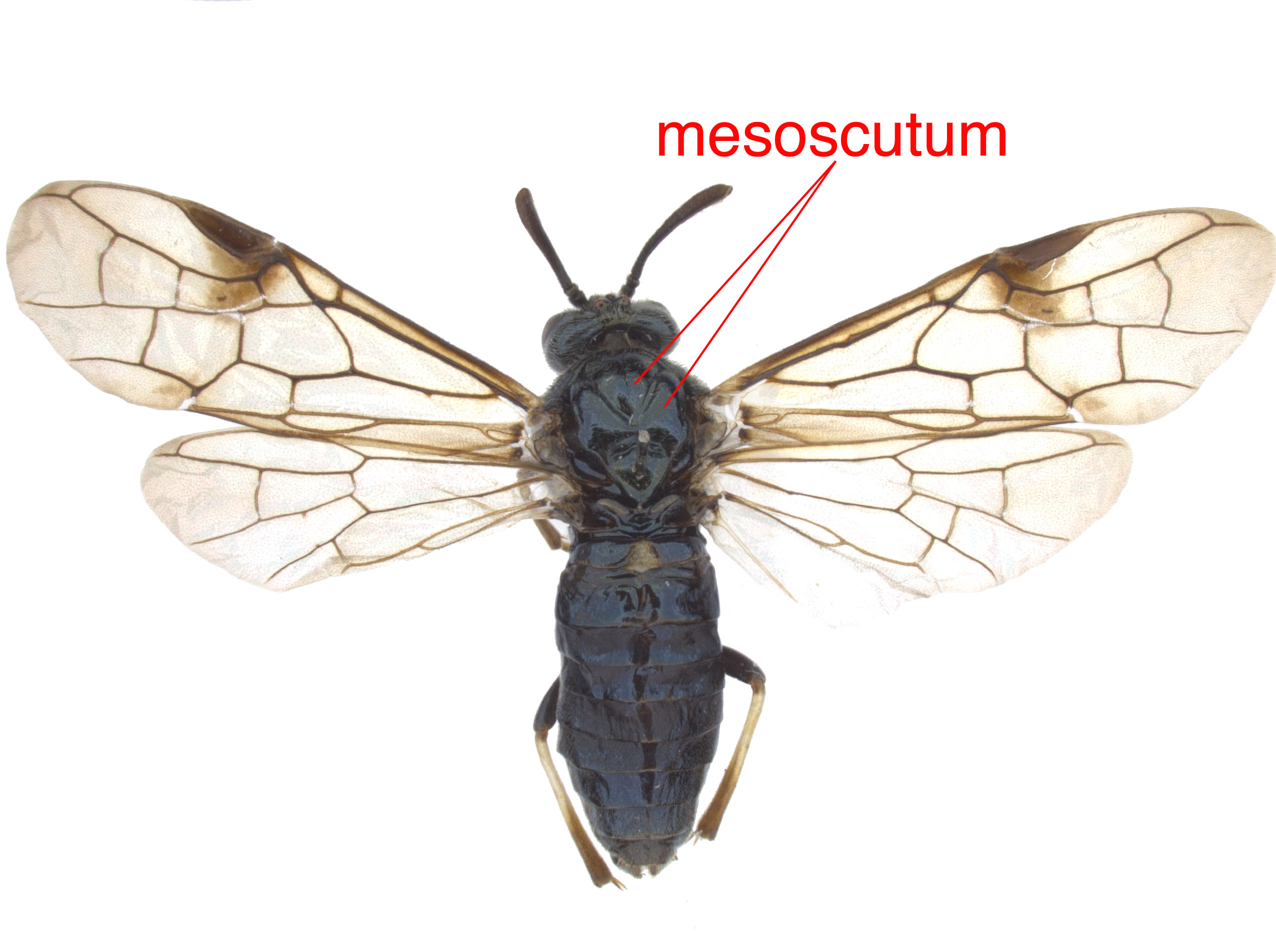 of the thoraxthorax:
of the thoraxthorax:
the second and middle segment of the body, between the head and abdomen
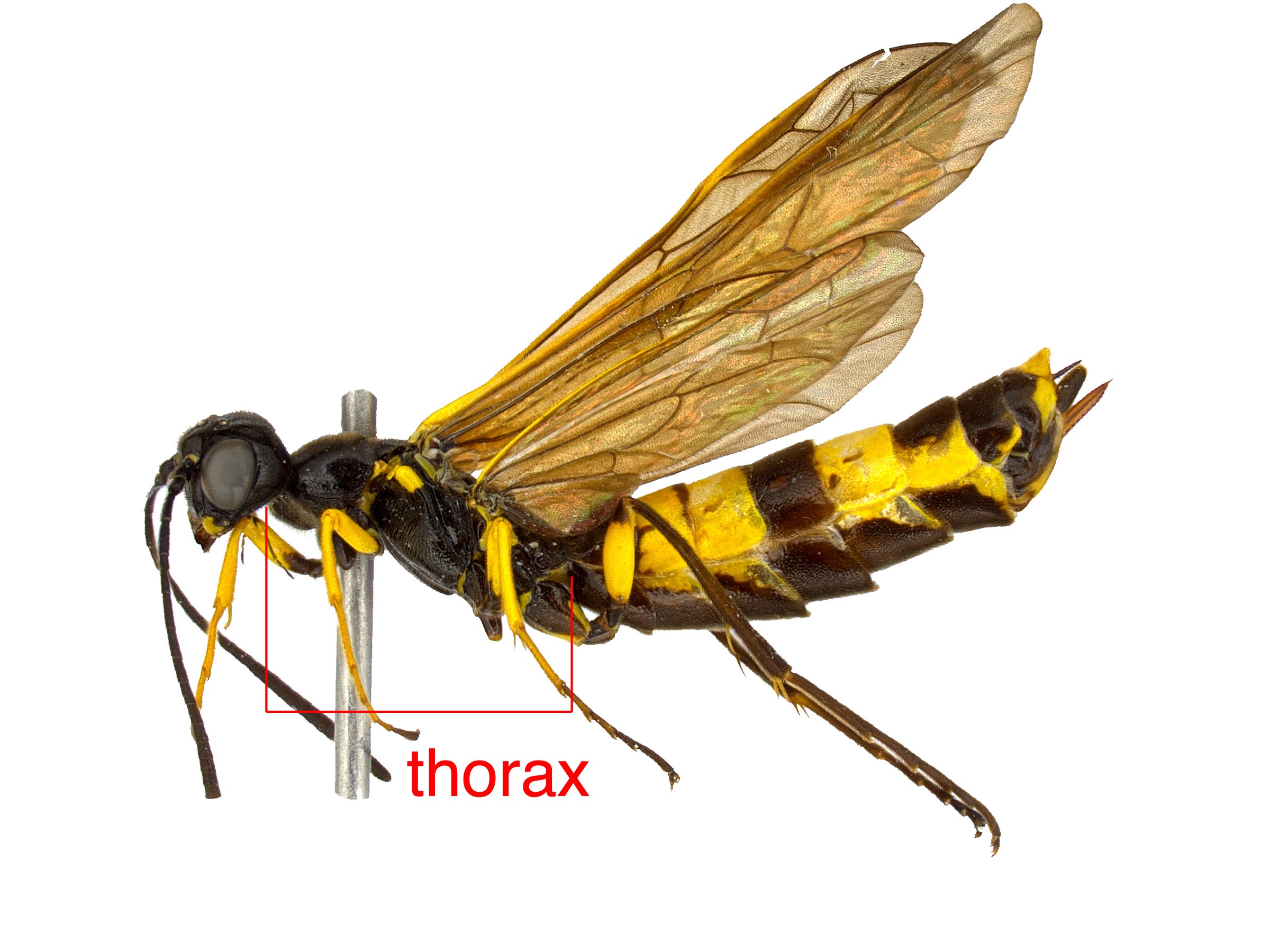 (Goulet 1992Goulet 1992:
(Goulet 1992Goulet 1992:
Goulet H. 1992. The genera and subgenera of the sawflies of Canada and Alaska: Hymenoptera. Symphyta. The insects and arachnids of Canada. Part 20. Agriculture Canada Publication.).
There are 260 described extantextant:
in existence; opposite of extinct
species worldwide. Eighty-four species occur in North America (Taeger et al. 2010Taeger et al. 2010:
Taeger A, Blank SM, and Liston AD. 2010. World Catalog of Symphyta (Hymenoptera). Zootaxa 2580: 1-1064.).
A key to NearcticNearctic:
describing the region of the Northern Hemisphere that includes North America south through northern Mexico
 species is included in Goulet 1986Goulet 1986:
species is included in Goulet 1986Goulet 1986:
Goulet H. 1986. The genera and species of the Nearctic Dolerini (Symphyta: Tenthredinidae: Selandriinae): classification and phylogeny. Memoirs of the Entomological Society of Canada 135: 1-208..
Subfamily characters
 vein Rs+M curved near intersection with veinvein:
vein Rs+M curved near intersection with veinvein: Sc+R (Smith 1969eSmith 1969e:
Sc+R (Smith 1969eSmith 1969e: vein M meeting Sc+R basalbasal:
vein M meeting Sc+R basalbasal: veins M and m-cu about parallel (Smith 1969eSmith 1969e:
veins M and m-cu about parallel (Smith 1969eSmith 1969e:Genus characters
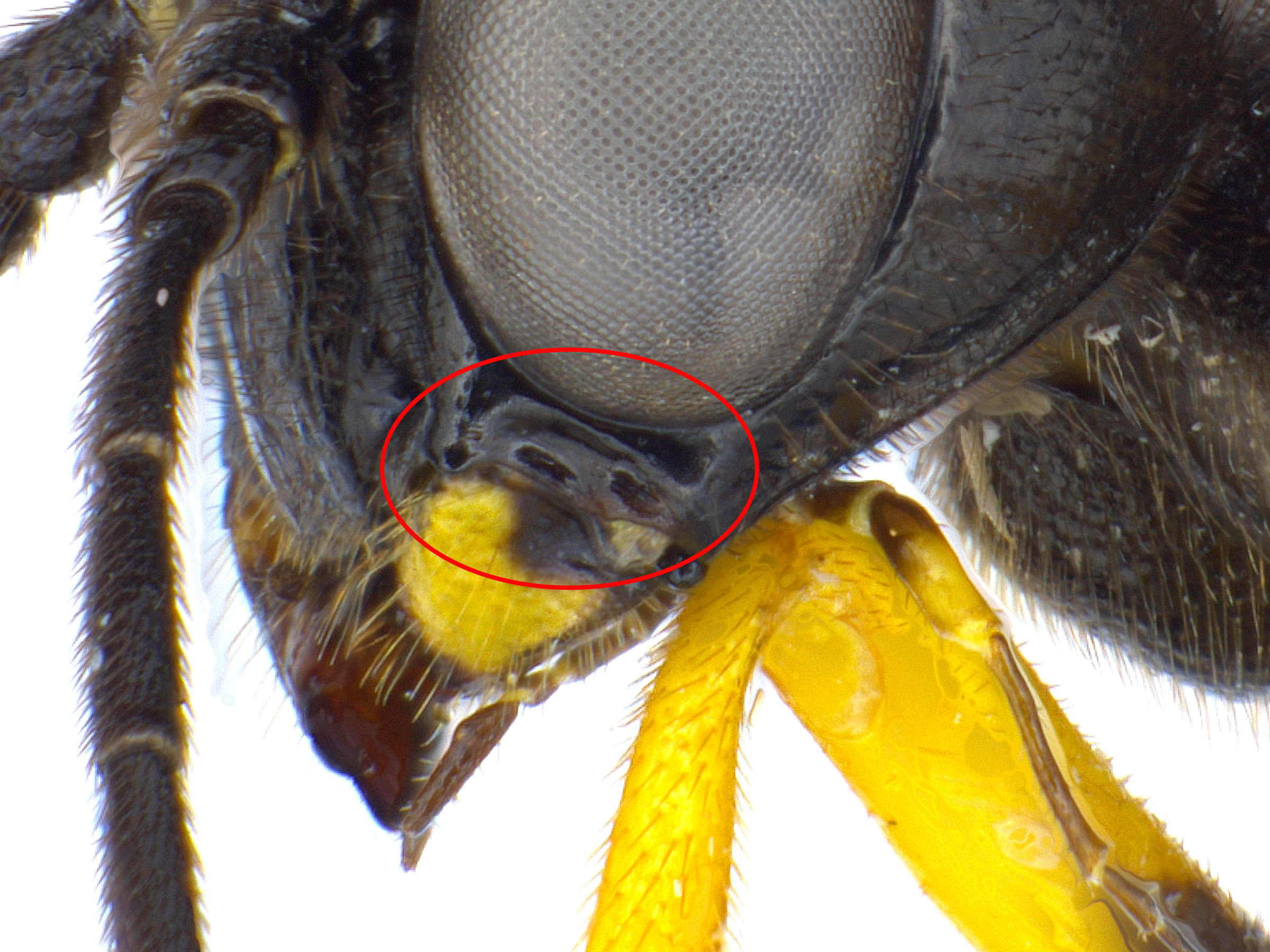 length more than one-third the dimeter of the antennal socket (Goulet 1992Goulet 1992:
length more than one-third the dimeter of the antennal socket (Goulet 1992Goulet 1992: deeply notched (Goulet 1992Goulet 1992:
deeply notched (Goulet 1992Goulet 1992: vein 2r-m usually absent (Goulet 1992Goulet 1992:
vein 2r-m usually absent (Goulet 1992Goulet 1992: anal crossveinanal crossvein:
anal crossveinanal crossvein: anal crossveinanal crossvein:
anal crossveinanal crossvein: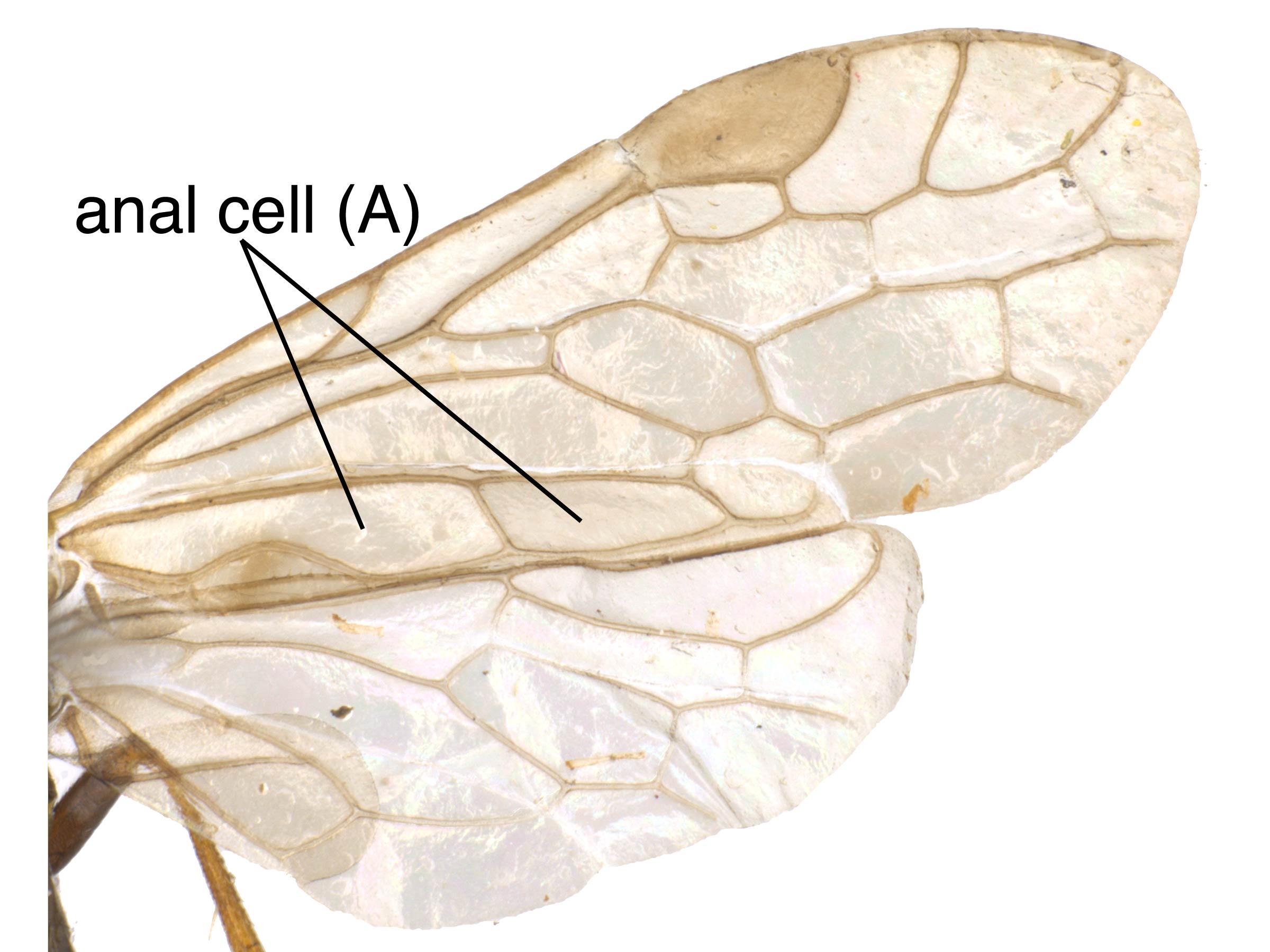 (Goulet 1992Goulet 1992:
(Goulet 1992Goulet 1992: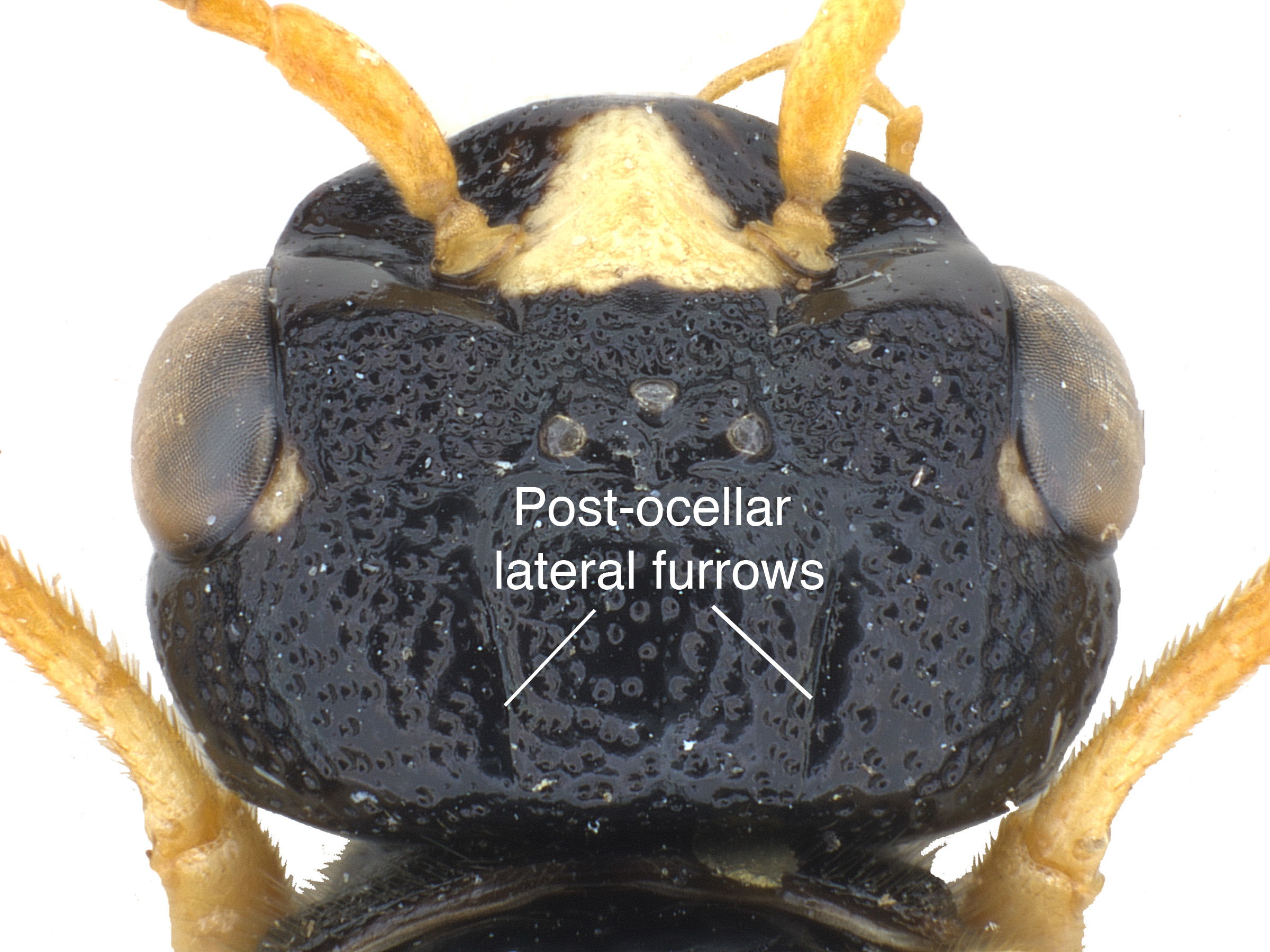 dividing the metepimeronmetepimeron:
dividing the metepimeronmetepimeron: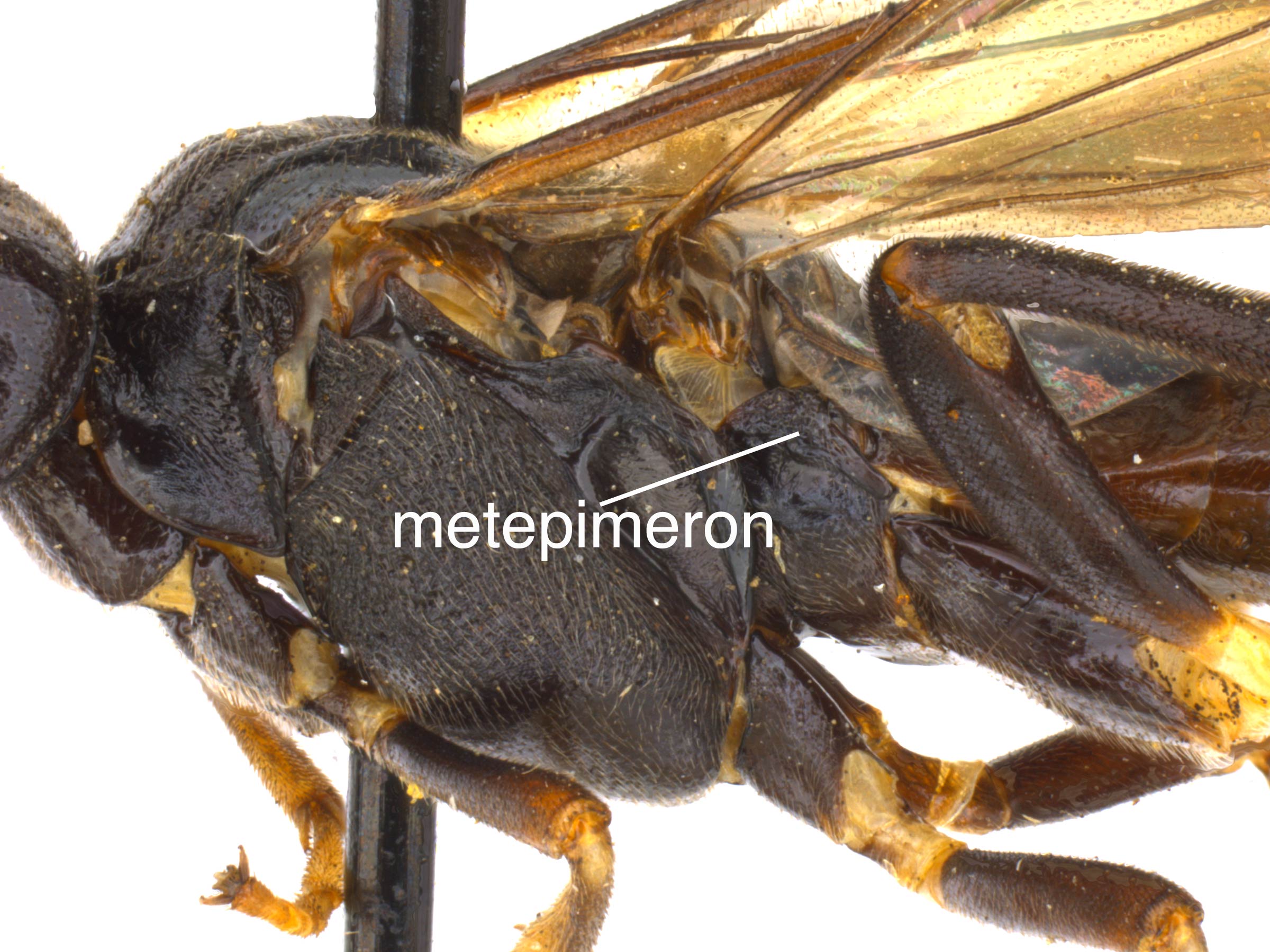 and metepisternummetepisternum:
and metepisternummetepisternum: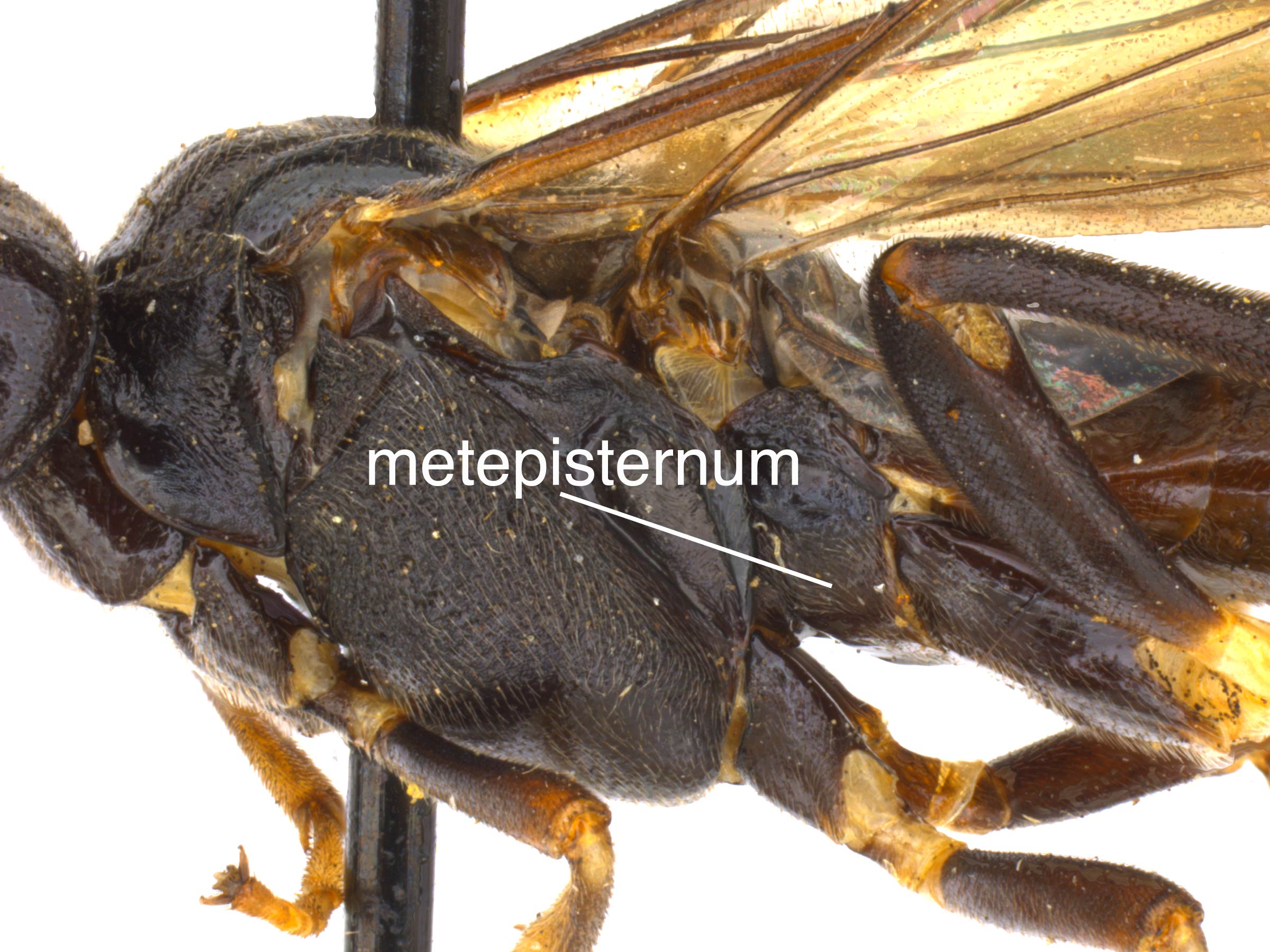 (Goulet 1992Goulet 1992:
(Goulet 1992Goulet 1992: (Goulet 1992Goulet 1992:
(Goulet 1992Goulet 1992: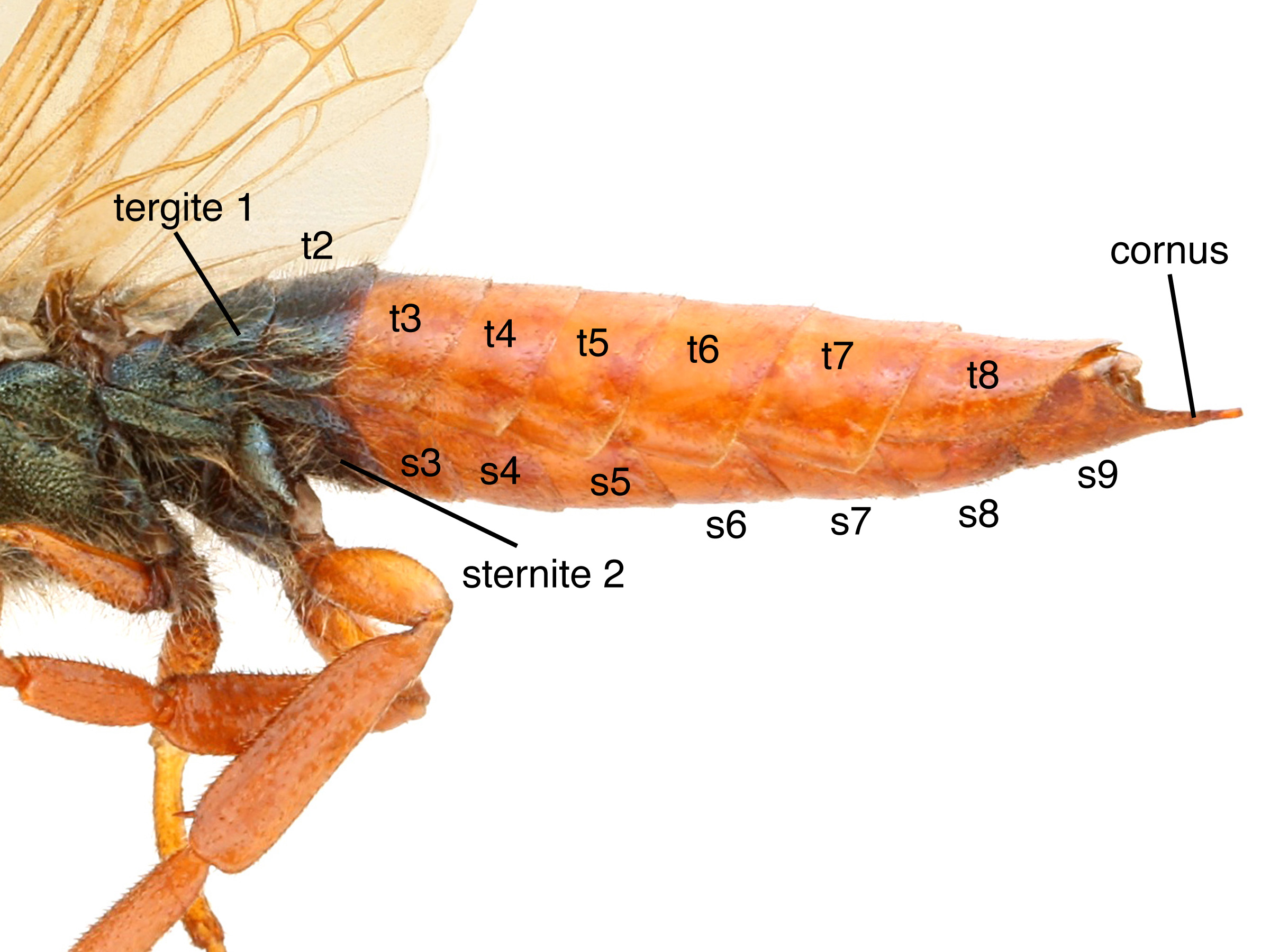 wide medially; membranous surface small (Goulet 1992Goulet 1992:
wide medially; membranous surface small (Goulet 1992Goulet 1992:Dolerus can be confused with similar species in the subfamily Selandriinae. It can be distinguished from most other genera by the distinct punctures on the head and mesoscutummesoscutum:
the central and dorsal portion of the thorax between the scutellum and postnotum
 , and from the other Dolerini genus in the tribe: Prionourgus by the malar spacemalar space:
, and from the other Dolerini genus in the tribe: Prionourgus by the malar spacemalar space:
the minimum distance between the base of the mandible and the ventral margin of the compound eye
 length and the clypeusclypeus:
length and the clypeusclypeus:
sclerotized area on the front of the head located between the antennal insertions and labrum
 margin (Goulet 1992Goulet 1992:
margin (Goulet 1992Goulet 1992:
Goulet H. 1992. The genera and subgenera of the sawflies of Canada and Alaska: Hymenoptera. Symphyta. The insects and arachnids of Canada. Part 20. Agriculture Canada Publication.).
Because Dolerus feeds on grasses, many of which are of agricultural importance, some species are considered pests. Dolerus puncticollis, also known as the wheat sawfly, is a minor pest of Triticum (wheat) in central Europe and in Iran (Ebrahimi et al. 2015Ebrahimi et al. 2015:
Ebrahimi L, Karbalaie H, Ziveh PS, Didehbaz G, and Dunphy GB. 2015. Susceptibility of larvae of wheat sawfly, Dolerus puncticollis (Tenthredinidae; Hymenoptera) to an entomopathogenic nematode, Steinernema carpocapsae and indoxacarb. Pakistan Entomologist: 37 (2): 79-82.); D. hematodes is a pest of various cereals, including Lolium perenne (perennial ryegrass), Festuca rubra (red fescue), Hordeum vulgare (spring barley), and Triticum (wheat) in Europe (Barker and Reynolds 2004Barker and Reynolds 2004:
Barker AM and Reynolds CJM. 2004. Do host-plant interactions and susceptibility to soil cultivation determine the abundance of graminivorous sawflies on British farmland? Journal of Agricultural and Urban Entomology 21 (4): 257-269.); D. nigratus is a pest of Triticum (wheat) in Europe (Zvankovich 2005Zvankovich 2005:
Zvankovich V. 2005. Spring wheat protection from major leafnibble pests. Proceedings of the National Academy of Sciences of Belarus, Agrarian Sciences Series (5): 106-108.); D. tritici is a pest of Triticum (wheat) in China; D. hordei is a pest of Hordeum (barley) in Japan (Haris 2000Haris 2000:
Haris A. 2000. Study on the Palaearctic Dolerus Panzer, 1801 species (Hymenoptera: Tenthredinidae). Folia Entomologica Hungarica 61: 95-148.); and D. ephippiatus and D. lewisi are pests of Triticum (wheat) in Japan (Hill 1987Hill 1987:
Hill DS. 1987. Agricultural insect pests of temperate regions and their control. Cambridge University Press, Cambridge UK.).
Dolerus nitens is introduced from Europe and is a pest of Festuca rubra (red fescue), reported as having caused extensive damage in some growing operations in Oregon (Smith 2006bSmith 2006b:
Smith DR. 2006b. List of the Sawflies (Hymenoptera: Symphyta) of Virginia. Banisteria 28: 3-23.). Dolerus brevicornis may also be introduced in North America (Heidemaa et al. 2004Heidemaa et al. 2004:
Heidemaa M, Nuorteva M, Hantula J, and Saarma U. 2004. Dolerus asper Zaddach, 1859 and Dolerus brevicornis Zaddach, 1859 (Hymenoptera: Tenthredinidae), with notes on their phylogeny. European Journal of Entomology 101: 637-650., Taeger et al. 2010Taeger et al. 2010:
Taeger A, Blank SM, and Liston AD. 2010. World Catalog of Symphyta (Hymenoptera). Zootaxa 2580: 1-1064.)
Dolerus nitens is introduced from Europe and is a pest of Festuca rubra (red fescue), reported as having caused extensive damage in some growing operations in Oregon (Smith 2006bSmith 2006b:
Smith DR. 2006b. List of the Sawflies (Hymenoptera: Symphyta) of Virginia. Banisteria 28: 3-23.). Dolerus brevicornis may also be introduced in North America (Heidemaa et al. 2004Heidemaa et al. 2004:
Heidemaa M, Nuorteva M, Hantula J, and Saarma U. 2004. Dolerus asper Zaddach, 1859 and Dolerus brevicornis Zaddach, 1859 (Hymenoptera: Tenthredinidae), with notes on their phylogeny. European Journal of Entomology 101: 637-650., Taeger et al. 2010Taeger et al. 2010:
Taeger A, Blank SM, and Liston AD. 2010. World Catalog of Symphyta (Hymenoptera). Zootaxa 2580: 1-1064.)
In North America, Dolerus feeds on rushes, grasses including Triticum (wheat) and Festuca (fescue), Carex (sedges), and Equisetum (horsetail) (Goulet 1986Goulet 1986:
Goulet H. 1986. The genera and species of the Nearctic Dolerini (Symphyta: Tenthredinidae: Selandriinae): classification and phylogeny. Memoirs of the Entomological Society of Canada 135: 1-208., Leblanc and Goulet 1992Goulet 1992:
Goulet H. 1992. The genera and subgenera of the sawflies of Canada and Alaska: Hymenoptera. Symphyta. The insects and arachnids of Canada. Part 20. Agriculture Canada Publication.).
Female Dolerus deposit eggs into plant tissue. LarvaeLarva:
the immature stage of holometabolous insects
 feed for about one month before entering maturity and dropping to the ground, where they burrow into the soil and build cells in which to overwinter. Dolerus is univoltineunivoltine:
feed for about one month before entering maturity and dropping to the ground, where they burrow into the soil and build cells in which to overwinter. Dolerus is univoltineunivoltine:
describing an insect with a life cycle of one generation per year
(Goulet 1986Goulet 1986:
Goulet H. 1986. The genera and species of the Nearctic Dolerini (Symphyta: Tenthredinidae: Selandriinae): classification and phylogeny. Memoirs of the Entomological Society of Canada 135: 1-208.).
Dolerus also feed as adults on tree sap from Acer (maple), Malus (apple), and Pyrus (pear), and on nectar from flowers of Salix (willow) and Prunus (cherry, plum) (Goulet 1986Goulet 1986:
Goulet H. 1986. The genera and species of the Nearctic Dolerini (Symphyta: Tenthredinidae: Selandriinae): classification and phylogeny. Memoirs of the Entomological Society of Canada 135: 1-208.).
World: The genus is widespread throughout North America, Europe and Asia, with one species in eastern Africa (Goulet 1992Goulet 1992:
Goulet H. 1992. The genera and subgenera of the sawflies of Canada and Alaska: Hymenoptera. Symphyta. The insects and arachnids of Canada. Part 20. Agriculture Canada Publication., Taeger et al. 2010Taeger et al. 2010:
Taeger A, Blank SM, and Liston AD. 2010. World Catalog of Symphyta (Hymenoptera). Zootaxa 2580: 1-1064.)
North America: Dolerus occurs throughout the United States and Canada, as far north as Alaska, and as far south as Arizona (Goulet 1986Goulet 1986:
Goulet H. 1986. The genera and species of the Nearctic Dolerini (Symphyta: Tenthredinidae: Selandriinae): classification and phylogeny. Memoirs of the Entomological Society of Canada 135: 1-208.).
Map data from: GBIF.org (29 October 2019) GBIF Occurrence Download Dolerus
Details about data used for maps can be found here.